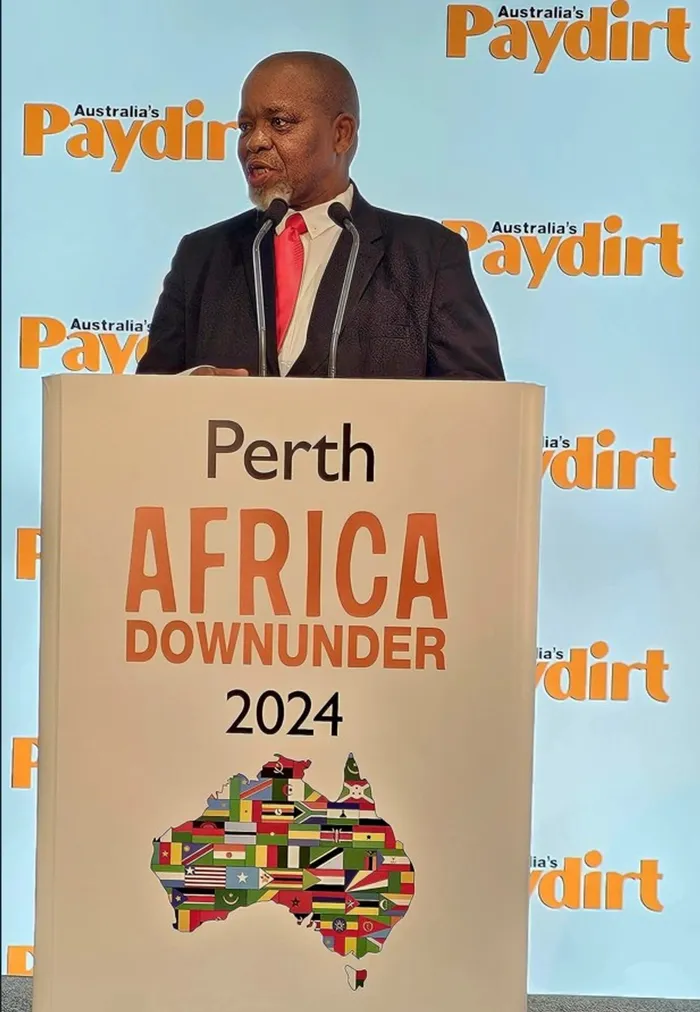Mantashe vows to address mining licences backlog to boost investment

Minerals Resources and Energy Minister, Gwede Mantashe, speaking on Wednesday at the Africa Down Under (ADU) Conference in Perth, Australia. Picture: Supplied
Mineral Resources and Energy Minister Gwede Mantashe has promised foreign investors that his department would in the next nine months address the delays in issuing of mining permits and exploration rights in South Africa.
This comes as more than 2 500 mining applications received in the 2023/24 financial year have not been finalised by the Department of Mineral Resources and Energy (DMRE) due to inadequate administrative capacity, dealing a blow to investment in the mining sector and the revenue that could be generated for the fiscus.
Delivering a keynote address at the Africa Down Under Conference in Perth, Australia, Mantashe the DMRE was making progress on the commitment he made last year to modernise the licensing system to ensure regulatory certainty.
“I can report to you that since the appointment of a service provider for the new system’s design, implementation, and maintenance, we have completed the first phase of the project’s life cycle whose major achievements include the completion of the assessment of the current environment to establish the baseline and its readiness from Information Communication and Technology infrastructure point of view,” Mantashe said.
“Furthermore, the requirements with respect to system hosting, software integration, the enhancement of cybersecurity in line with our governance principles have also been completed. In essence, the meticulous implementation of the new system is advancing very well with an intention to complete the migration process by June next year.”
Mantashe also defended the South African mining industry against dissenting views that it was transitioning slowly into new-age technologies, saying that there was a very strong case that the mining industry remained an attractive investment destination.
Mantashe yesterday said the South African mining industry was increasingly diversifying from an era that was associated with gold mining to an industry with a diverse range of mineral resources such as PGM, coal, gold, copper, manganese, vanadium, and other natural resources that sdre critical for a just transition.
“In our quest for an evidence-based state of the South African mining industry report, we have commissioned a study on ‘The State of Mining’ by the state-owned entity Mintek in collaboration with the Minerals Council SA, Mapungubwe Institute for Strategic Reflection, and researchers from reputable institutions of higher education,” Mantashe said.
“While the study is a work in progress, I can disclose that it considers several key factors, including but not limited to the contribution of mining to the economy and the performance and trends of each commodity in terms of production, exploration, exports, sales, employment, and prices.
“Coupled with this study is the development of South Africa’s ‘Critical Minerals Strategy’ to serve as the nation’s blueprint for the exploration, exploitation, and processing of these minerals.
“Whereas there is no universal consensus on the definition and categorisation of critical minerals, I can divulge that, to be fit-for purpose, the strategy ranks the criticality of each mineral using various methodologies such as supply risk, employment indicator, domestic and export sales indicators, and substitutability indicator among others.”
Mantashe said the government was convinced that at the conclusion of this work it would have evidence-based answers on how to address challenges facing the sector and consequently demystify any scepticism about South Africa’s mining industry, “which we described as a sunrise industry a few years ago”.
He said gold mining remained an integral component of South Africa’s mining industry, as evidenced by the 96 tons of gold production reached in 2023, despite being characterised by deep level mines and heightened safety concerns that directly impacted production.
Mantashe said the PGM sector had the potential to play a catalytic role not only in sustaining the South African mining industry, but in the growth of the economy and modernisation of its infrastructure since the country was the world’s largest producer of PGM.
Despite the pressure to phase out coal, Mantashe said coal mining was actively contributing to the nation’s strategic priorities of driving inclusive growth, job creation and reducing poverty.
He said coal production increased from 230 million tons in 2022 to 232 million tons in 2023.
“About 25% of the coal produced in our country gets exported to various countries, thus positioning South Africa as the fifth largest coal exporter,” he said.
“In light of these developments, we are certain that coal will continue to play an integral part in South Africa’s economy as the primary source of our energy generation.”
BUSINESS REPORT